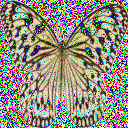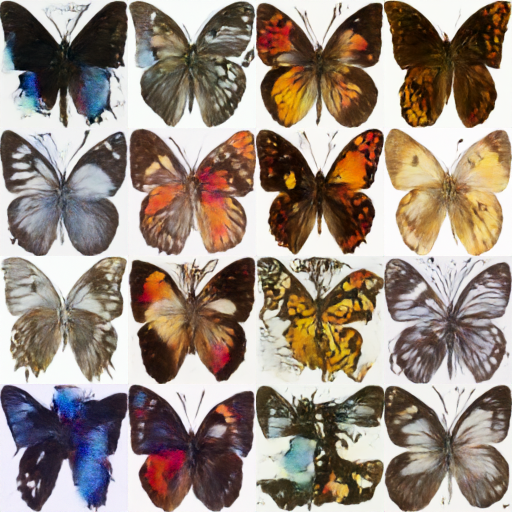Diffusers documentation
Train a diffusion model
Train a diffusion model
Unconditional image generation is a popular application of diffusion models that generates images that look like those in the dataset used for training. Typically, the best results are obtained from finetuning a pretrained model on a specific dataset. You can find many of these checkpoints on the Hub, but if you can’t find one you like, you can always train your own!
This tutorial will teach you how to train a UNet2DModel from scratch on a subset of the Smithsonian Butterflies dataset to generate your own 🦋 butterflies 🦋.
💡 This training tutorial is based on the Training with 🧨 Diffusers notebook. For additional details and context about diffusion models like how they work, check out the notebook!
Before you begin, make sure you have 🤗 Datasets installed to load and preprocess image datasets, and 🤗 Accelerate, to simplify training on any number of GPUs. The following command will also install TensorBoard to visualize training metrics (you can also use Weights & Biases to track your training).
!pip install diffusers[training]
We encourage you to share your model with the community, and in order to do that, you’ll need to login to your Hugging Face account (create one here if you don’t already have one!). You can login from a notebook and enter your token when prompted:
>>> from huggingface_hub import notebook_login
>>> notebook_login()Or login in from the terminal:
huggingface-cli login
Since the model checkpoints are quite large, install Git-LFS to version these large files:
!sudo apt -qq install git-lfs !git config --global credential.helper store
Training configuration
For convenience, create a TrainingConfig class containing the training hyperparameters (feel free to adjust them):
>>> from dataclasses import dataclass
>>> @dataclass
... class TrainingConfig:
... image_size = 128 # the generated image resolution
... train_batch_size = 16
... eval_batch_size = 16 # how many images to sample during evaluation
... num_epochs = 50
... gradient_accumulation_steps = 1
... learning_rate = 1e-4
... lr_warmup_steps = 500
... save_image_epochs = 10
... save_model_epochs = 30
... mixed_precision = "fp16" # `no` for float32, `fp16` for automatic mixed precision
... output_dir = "ddpm-butterflies-128" # the model name locally and on the HF Hub
... push_to_hub = True # whether to upload the saved model to the HF Hub
... hub_private_repo = False
... overwrite_output_dir = True # overwrite the old model when re-running the notebook
... seed = 0
>>> config = TrainingConfig()Load the dataset
You can easily load the Smithsonian Butterflies dataset with the 🤗 Datasets library:
>>> from datasets import load_dataset
>>> config.dataset_name = "huggan/smithsonian_butterflies_subset"
>>> dataset = load_dataset(config.dataset_name, split="train")💡 You can find additional datasets from the HugGan Community Event or you can use your own dataset by creating a local ImageFolder. Set config.dataset_name to the repository id of the dataset if it is from the HugGan Community Event, or imagefolder if you’re using your own images.
🤗 Datasets uses the Image feature to automatically decode the image data and load it as a PIL.Image which we can visualize:
>>> import matplotlib.pyplot as plt
>>> fig, axs = plt.subplots(1, 4, figsize=(16, 4))
>>> for i, image in enumerate(dataset[:4]["image"]):
... axs[i].imshow(image)
... axs[i].set_axis_off()
>>> fig.show()
The images are all different sizes though, so you’ll need to preprocess them first:
Resizechanges the image size to the one defined inconfig.image_size.RandomHorizontalFlipaugments the dataset by randomly mirroring the images.Normalizeis important to rescale the pixel values into a [-1, 1] range, which is what the model expects.
>>> from torchvision import transforms
>>> preprocess = transforms.Compose(
... [
... transforms.Resize((config.image_size, config.image_size)),
... transforms.RandomHorizontalFlip(),
... transforms.ToTensor(),
... transforms.Normalize([0.5], [0.5]),
... ]
... )Use 🤗 Datasets’ set_transform method to apply the preprocess function on the fly during training:
>>> def transform(examples):
... images = [preprocess(image.convert("RGB")) for image in examples["image"]]
... return {"images": images}
>>> dataset.set_transform(transform)Feel free to visualize the images again to confirm that they’ve been resized. Now you’re ready to wrap the dataset in a DataLoader for training!
>>> import torch
>>> train_dataloader = torch.utils.data.DataLoader(dataset, batch_size=config.train_batch_size, shuffle=True)Create a UNet2DModel
Pretrained models in 🧨 Diffusers are easily created from their model class with the parameters you want. For example, to create a UNet2DModel:
>>> from diffusers import UNet2DModel
>>> model = UNet2DModel(
... sample_size=config.image_size, # the target image resolution
... in_channels=3, # the number of input channels, 3 for RGB images
... out_channels=3, # the number of output channels
... layers_per_block=2, # how many ResNet layers to use per UNet block
... block_out_channels=(128, 128, 256, 256, 512, 512), # the number of output channels for each UNet block
... down_block_types=(
... "DownBlock2D", # a regular ResNet downsampling block
... "DownBlock2D",
... "DownBlock2D",
... "DownBlock2D",
... "AttnDownBlock2D", # a ResNet downsampling block with spatial self-attention
... "DownBlock2D",
... ),
... up_block_types=(
... "UpBlock2D", # a regular ResNet upsampling block
... "AttnUpBlock2D", # a ResNet upsampling block with spatial self-attention
... "UpBlock2D",
... "UpBlock2D",
... "UpBlock2D",
... "UpBlock2D",
... ),
... )It is often a good idea to quickly check the sample image shape matches the model output shape:
>>> sample_image = dataset[0]["images"].unsqueeze(0)
>>> print("Input shape:", sample_image.shape)
Input shape: torch.Size([1, 3, 128, 128])
>>> print("Output shape:", model(sample_image, timestep=0).sample.shape)
Output shape: torch.Size([1, 3, 128, 128])Great! Next, you’ll need a scheduler to add some noise to the image.
Create a scheduler
The scheduler behaves differently depending on whether you’re using the model for training or inference. During inference, the scheduler generates image from the noise. During training, the scheduler takes a model output - or a sample - from a specific point in the diffusion process and applies noise to the image according to a noise schedule and an update rule.
Let’s take a look at the DDPMScheduler and use the add_noise method to add some random noise to the sample_image from before:
>>> import torch
>>> from PIL import Image
>>> from diffusers import DDPMScheduler
>>> noise_scheduler = DDPMScheduler(num_train_timesteps=1000)
>>> noise = torch.randn(sample_image.shape)
>>> timesteps = torch.LongTensor([50])
>>> noisy_image = noise_scheduler.add_noise(sample_image, noise, timesteps)
>>> Image.fromarray(((noisy_image.permute(0, 2, 3, 1) + 1.0) * 127.5).type(torch.uint8).numpy()[0])
The training objective of the model is to predict the noise added to the image. The loss at this step can be calculated by:
>>> import torch.nn.functional as F
>>> noise_pred = model(noisy_image, timesteps).sample
>>> loss = F.mse_loss(noise_pred, noise)Train the model
By now, you have most of the pieces to start training the model and all that’s left is putting everything together.
First, you’ll need an optimizer and a learning rate scheduler:
>>> from diffusers.optimization import get_cosine_schedule_with_warmup
>>> optimizer = torch.optim.AdamW(model.parameters(), lr=config.learning_rate)
>>> lr_scheduler = get_cosine_schedule_with_warmup(
... optimizer=optimizer,
... num_warmup_steps=config.lr_warmup_steps,
... num_training_steps=(len(train_dataloader) * config.num_epochs),
... )Then, you’ll need a way to evaluate the model. For evaluation, you can use the DDPMPipeline to generate a batch of sample images and save it as a grid:
>>> from diffusers import DDPMPipeline
>>> import math
>>> import os
>>> def make_grid(images, rows, cols):
... w, h = images[0].size
... grid = Image.new("RGB", size=(cols * w, rows * h))
... for i, image in enumerate(images):
... grid.paste(image, box=(i % cols * w, i // cols * h))
... return grid
>>> def evaluate(config, epoch, pipeline):
... # Sample some images from random noise (this is the backward diffusion process).
... # The default pipeline output type is `List[PIL.Image]`
... images = pipeline(
... batch_size=config.eval_batch_size,
... generator=torch.manual_seed(config.seed),
... ).images
... # Make a grid out of the images
... image_grid = make_grid(images, rows=4, cols=4)
... # Save the images
... test_dir = os.path.join(config.output_dir, "samples")
... os.makedirs(test_dir, exist_ok=True)
... image_grid.save(f"{test_dir}/{epoch:04d}.png")Now you can wrap all these components together in a training loop with 🤗 Accelerate for easy TensorBoard logging, gradient accumulation, and mixed precision training. To upload the model to the Hub, write a function to get your repository name and information and then push it to the Hub.
💡 The training loop below may look intimidating and long, but it’ll be worth it later when you launch your training in just one line of code! If you can’t wait and want to start generating images, feel free to copy and run the code below. You can always come back and examine the training loop more closely later, like when you’re waiting for your model to finish training. 🤗
>>> from accelerate import Accelerator
>>> from huggingface_hub import HfFolder, Repository, whoami
>>> from tqdm.auto import tqdm
>>> from pathlib import Path
>>> import os
>>> def get_full_repo_name(model_id: str, organization: str = None, token: str = None):
... if token is None:
... token = HfFolder.get_token()
... if organization is None:
... username = whoami(token)["name"]
... return f"{username}/{model_id}"
... else:
... return f"{organization}/{model_id}"
>>> def train_loop(config, model, noise_scheduler, optimizer, train_dataloader, lr_scheduler):
... # Initialize accelerator and tensorboard logging
... accelerator = Accelerator(
... mixed_precision=config.mixed_precision,
... gradient_accumulation_steps=config.gradient_accumulation_steps,
... log_with="tensorboard",
... logging_dir=os.path.join(config.output_dir, "logs"),
... )
... if accelerator.is_main_process:
... if config.push_to_hub:
... repo_name = get_full_repo_name(Path(config.output_dir).name)
... repo = Repository(config.output_dir, clone_from=repo_name)
... elif config.output_dir is not None:
... os.makedirs(config.output_dir, exist_ok=True)
... accelerator.init_trackers("train_example")
... # Prepare everything
... # There is no specific order to remember, you just need to unpack the
... # objects in the same order you gave them to the prepare method.
... model, optimizer, train_dataloader, lr_scheduler = accelerator.prepare(
... model, optimizer, train_dataloader, lr_scheduler
... )
... global_step = 0
... # Now you train the model
... for epoch in range(config.num_epochs):
... progress_bar = tqdm(total=len(train_dataloader), disable=not accelerator.is_local_main_process)
... progress_bar.set_description(f"Epoch {epoch}")
... for step, batch in enumerate(train_dataloader):
... clean_images = batch["images"]
... # Sample noise to add to the images
... noise = torch.randn(clean_images.shape).to(clean_images.device)
... bs = clean_images.shape[0]
... # Sample a random timestep for each image
... timesteps = torch.randint(
... 0, noise_scheduler.config.num_train_timesteps, (bs,), device=clean_images.device
... ).long()
... # Add noise to the clean images according to the noise magnitude at each timestep
... # (this is the forward diffusion process)
... noisy_images = noise_scheduler.add_noise(clean_images, noise, timesteps)
... with accelerator.accumulate(model):
... # Predict the noise residual
... noise_pred = model(noisy_images, timesteps, return_dict=False)[0]
... loss = F.mse_loss(noise_pred, noise)
... accelerator.backward(loss)
... accelerator.clip_grad_norm_(model.parameters(), 1.0)
... optimizer.step()
... lr_scheduler.step()
... optimizer.zero_grad()
... progress_bar.update(1)
... logs = {"loss": loss.detach().item(), "lr": lr_scheduler.get_last_lr()[0], "step": global_step}
... progress_bar.set_postfix(**logs)
... accelerator.log(logs, step=global_step)
... global_step += 1
... # After each epoch you optionally sample some demo images with evaluate() and save the model
... if accelerator.is_main_process:
... pipeline = DDPMPipeline(unet=accelerator.unwrap_model(model), scheduler=noise_scheduler)
... if (epoch + 1) % config.save_image_epochs == 0 or epoch == config.num_epochs - 1:
... evaluate(config, epoch, pipeline)
... if (epoch + 1) % config.save_model_epochs == 0 or epoch == config.num_epochs - 1:
... if config.push_to_hub:
... repo.push_to_hub(commit_message=f"Epoch {epoch}", blocking=True)
... else:
... pipeline.save_pretrained(config.output_dir)Phew, that was quite a bit of code! But you’re finally ready to launch the training with 🤗 Accelerate’s notebook_launcher function. Pass the function the training loop, all the training arguments, and the number of processes (you can change this value to the number of GPUs available to you) to use for training:
>>> from accelerate import notebook_launcher
>>> args = (config, model, noise_scheduler, optimizer, train_dataloader, lr_scheduler)
>>> notebook_launcher(train_loop, args, num_processes=1)Once training is complete, take a look at the final 🦋 images 🦋 generated by your diffusion model!
>>> import glob
>>> sample_images = sorted(glob.glob(f"{config.output_dir}/samples/*.png"))
>>> Image.open(sample_images[-1])
Next steps
Unconditional image generation is one example of a task that can be trained. You can explore other tasks and training techniques by visiting the 🧨 Diffusers Training Examples page. Here are some examples of what you can learn:
- Textual Inversion, an algorithm that teaches a model a specific visual concept and integrates it into the generated image.
- DreamBooth, a technique for generating personalized images of a subject given several input images of the subject.
- Guide to finetuning a Stable Diffusion model on your own dataset.
- Guide to using LoRA, a memory-efficient technique for finetuning really large models faster.